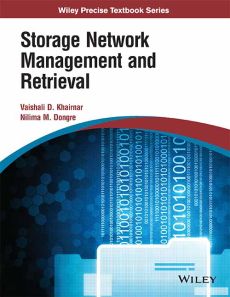Storage Network Management and Retrieval
ISBN: 9788126558667
500 pages
eBook also available for institutional users
For more information write to us at: acadmktg@wiley.com

Description
This book introduces you to the basic and advance concepts of Storage Network Management and Retrieval. It first gives introduction to storage system and basic components of the storage system network and further covers standard storage like RAID, ISS, SAN, NAS, Storage Virtualisation, Backup and Business Continuity, Information Retrieval. The book explores new technology in Storage Area Networks and Backup. Different types of backup techniques and information retrieval techniques are explored. The book also explains in detail, document and query forms, matching process and text analysis in information retrieval.
Lab sessions on above techniques including Post Lab Assignment are also provided. Student activity which should be performed by the students in lab session is also covered.
1 Introduction to Storage System
1.1 Information: Creation and Access
1.2 Data and Information
1.3 Information Storage with Storage-Oriented Architecture
1.4 Storage Systems
1.5 Data Centre Infrastructure
1.6 Challenges of Managing Information
1.7 Information Lifecycle
2 Basics of Storage System Network
2.1 Components of Storage System
2.2 Basic HDD Elements
2.3 Disk Drive Performance
2.4 Fundamental Laws Governing Disk Performance
2.5 Logical Components of the Host
3 Data Protection
3.1 RAID Implementation
3.2 Software RAID
3.3 Hardware RAID
3.4 RAID Array Components
3.5 RAID Technologies
3.6 RAID Levels
3.7 RAID Impact on Disk Performance
3.8 RAID Level Comparison
4 Intelligent Storage System
4.1 Basic Components of ISS Architecture
4.2 Storage Provisioning
4.3 Types of ISS
5 Storage Network Architecture
5.1 The Physical I/O Path from the CPU to the Storage System
5.2 SCSI
5.3 The Fibre Channel Protocol Stack
5.4 Fibre Channel SAN
5.5 IP Storage
5.6 InfiniBand
5.7 Virtual Interface Architecture (VIA)
6 Network Attached Storage
6.1 Local File System
6.2 Network File Systems and File Servers
6.3 Shared Disk File Systems
6.4 Comparison of Fibre Channel SAN, FCoE SAN, iSCSI SAN and NAS
7 Storage Virtualisation
7.1 Virtualisation in Input/Output Path
7.2 Limitations and Requirements
7.3 Definition of Storage Virtualisation
7.4 Implementation
7.5 Storage Virtualisation on Block or File Level
7.6 Storage Virtualisation on Various Levels of the Storage Network
7.7 Symmetric and Asymmetric Virtualisation
8 Storage Network Backup and Recovery
8.1 Introduction to Business Continuity
8.2 General Conditions for Backup
8.3 Backup Considerations
8.4 Backup Granularity
8.5 Network Backup Services
8.6 Backup Clients
8.7 Performance Bottlenecks of Network Backup
8.8 Backup File Systems
8.9 Next Generation Backup
8.10 Backup of Databases
9 Information Retrieval in Storage Network
9.1 Overview
9.2 Data and Information
9.3 Abstraction
9.4 Information System
9.5 Measures
9.5 From Data to Wisdom
10 Document and Query Forms
10.1 Document Concept
10.2 Data Structures in Large
10.3 Document Surrogates
10.4 Vocabulary Control
10.5 Fine Structure of Data
10.6 Data Compression
10.7 Text Documents
10.8 Images and Sound
10.9 Query Structures
11 The Matching Process
11.1 Relevance and Similarity Measures
11.2 Boolean-Based Matching
11.3 Vector-Based Matching
11.4 Missing Terms and Term Relationships
11.5 Probabilistic Matching
11.6 Fuzzy Matching
11.7 Proximity Matching
11.8 Effects of Weighting
11.9 Effects of Scaling
11.10 Data Fusion
11.11 User-Centred View
12 Text Analysis
12.1 Indexing
12.2 Matrix Representation
12.3 Term Extraction and Analysis
12.4 Term Association
12.5 Stemming
12.6 Multilingual Retrieval Systems
Summary
Key Terms
Multiple Choice Questions
Descriptive Questions
Review Questions
Answers
Appendix: Student Activity
Experiment No. 1
Experiment No. 2
Experiment No. 3
Experiment No. 4
Experiment No. 5
Experiment No. 6
Experiment No. 7
Experiment No. 8
Experiment No. 9
Experiment No. 10
References
Index

